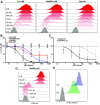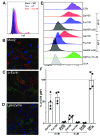Fucose-Galactose Polymers Inhibit Cholera Toxin Binding to Fucosylated Structures and Galactose-Dependent Intoxication of Human Enteroids
- PMID: 32134631
- PMCID: PMC7227030
- DOI: 10.1021/acsinfecdis.0c00009
Fucose-Galactose Polymers Inhibit Cholera Toxin Binding to Fucosylated Structures and Galactose-Dependent Intoxication of Human Enteroids
Abstract
A promising strategy to limit cholera severity involves blockers mimicking the canonical cholera toxin ligand (CT) ganglioside GM1. However, to date the efficacies of most of these blockers have been evaluated in noncellular systems that lack ligands other than GM1. Importantly, the CT B subunit (CTB) has a noncanonical site that binds fucosylated structures, which in contrast to GM1 are highly expressed in the human intestine. Here we evaluate the capacity of norbornene polymers displaying galactose and/or fucose to block CTB binding to immobilized protein-linked glycan structures and also to primary human and murine small intestine epithelial cells (SI ECs). We show that the binding of CTB to human SI ECs is largely dependent on the noncanonical binding site, and interference with the canonical site has a limited effect while the opposite is observed with murine SI ECs. The galactose-fucose polymer blocks binding to fucosylated glycans but not to GM1. However, the preincubation of CT with the galactose-fucose polymer only partially blocks toxic effects on cultured human enteroid cells, while preincubation with GM1 completely blocks CT-mediated secretion. Our results support a model whereby the binding of fucose to the noncanonical site places CT in close proximity to scarcely expressed galactose receptors such as GM1 to enable binding via the canonical site leading to CT internalization and intoxication. Our finding also highlights the importance of complementing CTB binding studies with functional intoxication studies when assessing the efficacy inhibitors of CT.
Keywords: cholera toxin; fucose; galactose; inhibition; multivalent glycopolymer; norbornene.
Conflict of interest statement
The authors declare no competing financial interest.
Figures






Similar articles
-
Targeting Multiple Binding Sites on Cholera Toxin B with Glycomimetic Polymers Promotes the Formation of Protein-Polymer Aggregates.Biomacromolecules. 2020 Dec 14;21(12):4878-4887. doi: 10.1021/acs.biomac.0c01122. Epub 2020 Oct 5. Biomacromolecules. 2020. PMID: 32960582 Free PMC article.
-
Cholera intoxication of human enteroids reveals interplay between decoy and functional glycoconjugate ligands.Glycobiology. 2023 Oct 30;33(10):801-816. doi: 10.1093/glycob/cwad069. Glycobiology. 2023. PMID: 37622990 Free PMC article.
-
Fucosylated Molecules Competitively Interfere with Cholera Toxin Binding to Host Cells.ACS Infect Dis. 2018 May 11;4(5):758-770. doi: 10.1021/acsinfecdis.7b00085. Epub 2018 Feb 22. ACS Infect Dis. 2018. PMID: 29411974 Free PMC article.
-
Fluorescence analysis of galactose, lactose, and fucose interaction with the cholera toxin B subunit.Biochem Biophys Res Commun. 1996 Sep 4;226(1):140-4. doi: 10.1006/bbrc.1996.1323. Biochem Biophys Res Commun. 1996. PMID: 8806604
-
Cholera toxin B: one subunit with many pharmaceutical applications.Toxins (Basel). 2015 Mar 20;7(3):974-96. doi: 10.3390/toxins7030974. Toxins (Basel). 2015. PMID: 25802972 Free PMC article. Review.
Cited by
-
Targeting Multiple Binding Sites on Cholera Toxin B with Glycomimetic Polymers Promotes the Formation of Protein-Polymer Aggregates.Biomacromolecules. 2020 Dec 14;21(12):4878-4887. doi: 10.1021/acs.biomac.0c01122. Epub 2020 Oct 5. Biomacromolecules. 2020. PMID: 32960582 Free PMC article.
-
Lipid Rafts in Signalling, Diseases, and Infections: What Can Be Learned from Fluorescence Techniques?Membranes (Basel). 2025 Jan 1;15(1):6. doi: 10.3390/membranes15010006. Membranes (Basel). 2025. PMID: 39852247 Free PMC article. Review.
-
Chemoenzymatic synthesis of sialylated and fucosylated mucin analogs reveals glycan-dependent effects on protein conformation and degradation.RSC Chem Biol. 2025 Jul 14;6(8):1336-1352. doi: 10.1039/d5cb00111k. eCollection 2025 Jul 30. RSC Chem Biol. 2025. PMID: 40677303 Free PMC article.
-
Advancements in understanding bacterial enteritis pathogenesis through organoids.Mol Biol Rep. 2024 Apr 15;51(1):512. doi: 10.1007/s11033-024-09495-5. Mol Biol Rep. 2024. PMID: 38622483 Review.
-
Heat-labile enterotoxin enhances F4-producing enterotoxigenic E. coli adhesion to porcine intestinal epithelial cells by upregulating bacterial adhesins and STb enterotoxin.Vet Res. 2022 Oct 27;53(1):88. doi: 10.1186/s13567-022-01110-4. Vet Res. 2022. PMID: 36303242 Free PMC article.
References
-
- Sarkar K. (2003) Role of oral rehydration therapy in controlling epidemic of cholera and watery diarrhoea. J. Indian Med. Assoc 101 (6), 379–386. - PubMed
Publication types
MeSH terms
Substances
Grants and funding
LinkOut - more resources
Full Text Sources

